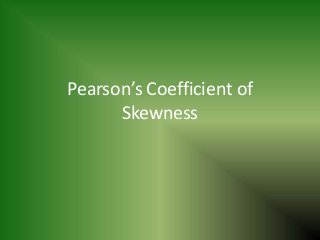
Pearson’s coefficient of skewness
- 1. Pearson’s Coefficient of Skewness
- 2. Karl Pearson developed two methods to find Skewness in a sample. 1. Pearson’s Coefficient of Skewness #1 uses the mode. The formula is: Where = the mean, Mo = the mode and s = the standard deviation for the sample.
- 3. 2. Pearson’s Coefficient of Skewness #2 uses the median. The formula is: Where = the mean, Mo = the mode and s = the standard deviation for the sample. It is generally used when you don’t know the mode.
- 4. Sample problem: Use Pearson’s Coefficient of Skewness #1 and Pearson’s Coefficient of Skewness #2 to find the skewness for data with the following characteristics: • Mean = 70.5. • Median = 80. • Mode = 85. • Standard deviation = 19.33.
- 5. • Pearson’s Coefficient of Skewness #1 (Mode): Step 1: Subtract the mode from the mean: 70.5 – 85 = -14.5. Step 2: Divide by the standard deviation: -14.5 / 19.33 = -0.75. • Pearson’s Coefficient of Skewness #2 (Median): Step 1: Subtract the median from the mean: 70.5 – 80 = -9.5. Step 2: Divide by the standard deviation: -9.5 / 19.33 = -1.47.
- 6. • Caution: Pearson’s first coefficient of skewness uses the mode. Therefore, if the mode is made up of too few pieces of data it won’t be a stable measure of central tendency. For example, the mode in both these sets of data is 9: 1 2 3 4 5 6 7 8 9 9. 1 2 3 4 5 6 7 8 9 9 9 9 9 9 9 9 9 9 9 9 10 12 12 13. In the first set of data, the mode only appears twice. This isn’t a good measure of central tendency so you would be cautioned not to use Pearson’s coefficient of skewness. The second set of data has a more stable set (the mode appears 12 times). Therefore, Pearson’s coefficient of skewness will likely give you a reasonable result.
